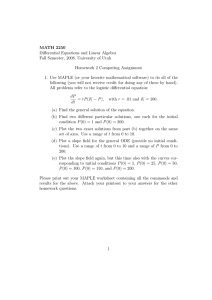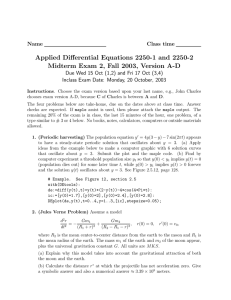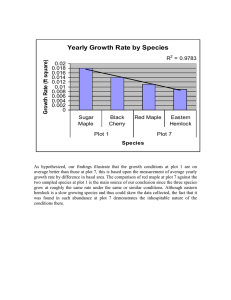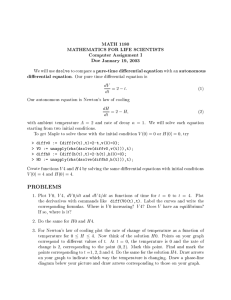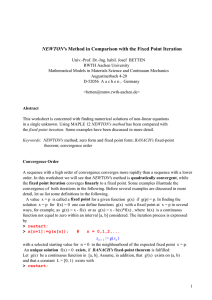Math 2250-03 Mechanical Oscillations - Maple Project 2 Notes and assignment
advertisement
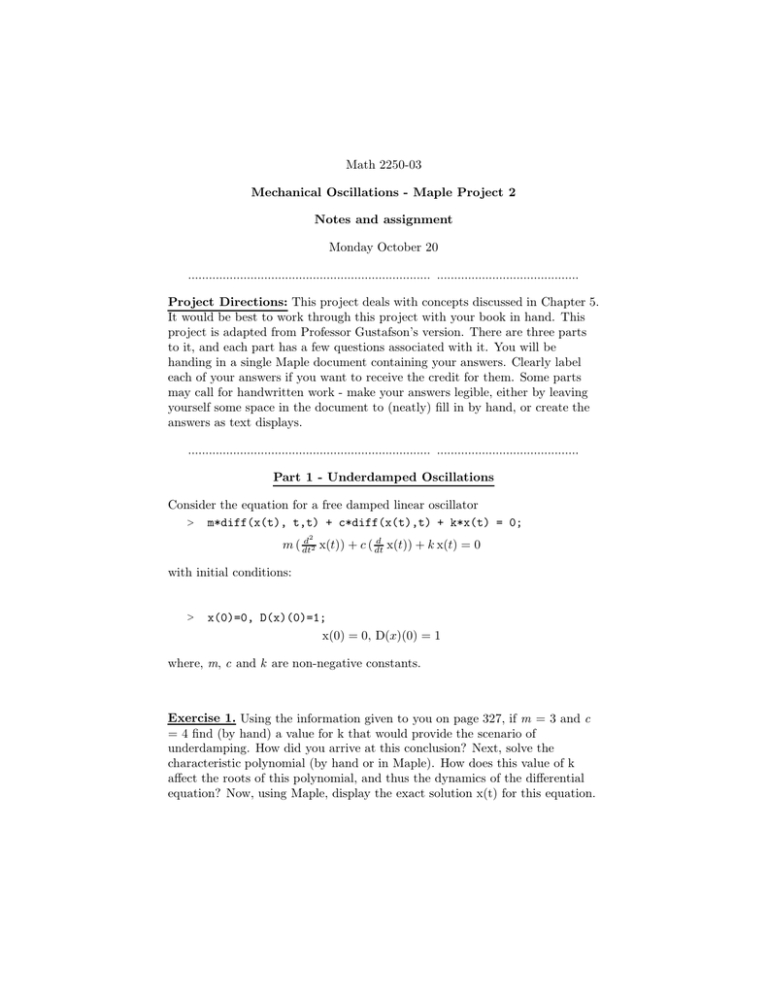
Math 2250-03
Mechanical Oscillations - Maple Project 2
Notes and assignment
Monday October 20
...................................................................... .........................................
Project Directions: This project deals with concepts discussed in Chapter 5.
It would be best to work through this project with your book in hand. This
project is adapted from Professor Gustafson’s version. There are three parts
to it, and each part has a few questions associated with it. You will be
handing in a single Maple document containing your answers. Clearly label
each of your answers if you want to receive the credit for them. Some parts
may call for handwritten work - make your answers legible, either by leaving
yourself some space in the document to (neatly) fill in by hand, or create the
answers as text displays.
...................................................................... .........................................
Part 1 - Underdamped Oscillations
Consider the equation for a free damped linear oscillator
> m*diff(x(t), t,t) + c*diff(x(t),t) + k*x(t) = 0;
2
d
d
m ( dt
2 x(t)) + c ( dt x(t)) + k x(t) = 0
with initial conditions:
>
x(0)=0, D(x)(0)=1;
x(0) = 0, D(x)(0) = 1
where, m, c and k are non-negative constants.
Exercise 1. Using the information given to you on page 327, if m = 3 and c
= 4 find (by hand) a value for k that would provide the scenario of
underdamping. How did you arrive at this conclusion? Next, solve the
characteristic polynomial (by hand or in Maple). How does this value of k
affect the roots of this polynomial, and thus the dynamics of the differential
equation? Now, using Maple, display the exact solution x(t) for this equation.
Exercise 2. Plot the solution x(t) vs. time. You should get something that
looks like Figure 5.4.9 on page 328. Now on the same graph, include the plot
of the decaying exponential.
Exercise 3. From your plot found in Exercise 2, estimate the value of the
pseudoperiod. You can click with the mouse on the graphic to print the cursor
location in the left upper corner of the maple window. The coordinates printed
are of the form (x,y). From this coordinate information, you can estimate the
period by simple subtraction.
Next, find the exact pseudoperiod as given on page 328 of your book. Do
theses two values agree?
...................................................................... .........................................
A little bit of sample code to help you on your way through Part 1 (as found
on Prof. Gustafson’s page...)
> restart: #clear all old definitions from memory
> with(DEtools):
#load the DE library of commands
> with(plots):
> #Note: in your code, use semicolons... and use your numbers
#rather
> than letters for the mass, spring, and damping #constants.
> #Defining the differential equation
> de:= m*diff(x(t), t,t) + c*diff(x(t),t) + k*x = 0:
> #solving the characteristic polynomial can be done with
> solve(a*r^2+b*r+c=0,r):
> #Defining initial conditions
> ic:= x(0)=d, D(x)(0)=f:
> #Symbolically solve for x(t)
> p:=dsolve({de,ic}, x(t), method=laplace):
> #Capture the dsolve symbolic solution as a function of X(t)
> X:= unapply(rhs(p),t):
> #Plot the solution
> plot(X(t), t=0..5):
...................................................................... ........................................
Part 2 - Undamped Forced Oscillations
Consider the undamped (c=0) forced problem
>
m*diff(x(t), t,t) + k*x(t) = 5*cos(omega*t);
2
d
m ( dt
2 x(t)) + k x(t) = 5 cos(ω t)
with initial conditions
> x(0)=0, D(x)(0)=0;
x(0) = 0, D(x)(0) = 0
where m, k and w are non-negative constants. For this problem, assume that
m=3 and k=4.5. Start by reading through pages 349-352 so you know where
you are headed.
Exercise 4. Choose the forcing angular frequency to be 3 times larger than
the natural angular frequency (see page 349) . Solve for x(t) using dsolve. Plot
the solution on a suitable interval in order to show the global behavior of the
solution x(t). You should get something that looks like Figure 5.6.2 on page
350.
Exercise 5. The solution x(t) is the sum of two functions, one of period
2Pi/w and the other of period 2Pi/w0. Using your solution to x(t) from
Exercise 4 (and page 350 as a guide), what is the value of the exact period?
Exercise 6. Suggest a value for the forcing frequency so that the oscillations
exhibit resonance (show how you arrive at this value). Make a graph of
resonant behavior as in Figure 5.6.4 on page 352.
...................................................................... ........................................
Tips for Part 2- With a little modification, you can use the same code as in
part 1.
...................................................................... ........................................
Part 3 - Resonance
Finally, we will consider a scenario with elements from Part 1 and Part 2.
Consider a damped forced problem,
> m*diff(x(t), t,t) + c*diff(x(t),t) + k*x(t) = 5*cos(w*t);
2
d
d
m ( dt
2 x(t)) + c ( dt x(t)) + k x(t) = 5 cos(w t)
with initial conditions:
>
x(0)=0, D(x)(0)=0;
x(0) = 0, D(x)(0) = 0
and now assume that m = 3 and k = 45.
Exercise 7. Consider the damping constants c=2, c=1, and c=1/2. Compute
the amplitude function C(w) as found on page 357 of your text for these three
equations, then plot three amplitude graphs on a single set of axes for w = 0
to 20. You should end up with three curves that look like that of Figure 5.6.9
on page 357.
Exercise 8. Using the mouse on your plot of this graph, find the values of w*
and C* for the three separate cases, where C* is the maximum value of the
amplitude function in your plot (you should end up with a table of six values).
You will find that as c -> 0, C* gets larger and larger. What does this tell you
about the model?
...................................................................... ........................................
>
>
>
>
Some sample code for Part 3
#First, define your parameters, then
F:=f: m:=g: k:=h: c:=’c’: w:=’w’:
C:=(w,c)->F/sqrt((k-m*w*w)^2+(c*w)^2):
plot({C(w,c1), C(w,c2), C(w,c3)},w=0..20,color=black):
...................................................................... ........................................

